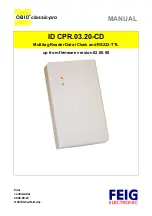
S o f t w a r e C o n f i g u r a t i o n s
34
S
I
C
K
O
p
t
i
c
-
E
l
e
c
t
r
o
n
i
c
B
a
r
C
o
d
e
S
c
a
n
n
e
r
s
3
CLOCK PULSE
The reading gate is initiated by a clock pulse (trigger device), which synchronizes the scanning process with the occurrence of a
printed bar code in the field of view. The CLV accepts these different trigger sources: an external clock pulse generator (hardware
trigger), [host device command strings (serial interface)], [internal clock pulse generation (free-running)] and reflector polling (use
of a special bar code for automatic triggering). The different trigger sources are shown in Figure 3-19.
Source Clock Pulse
Select one of the following options to configure the source of the clock pulse:
“Sensor Input”(active high), is selected if the clock pulse originates from a switching
input such as a photoelectric device. “Sensor Input” (active low) is selected when the
sensor input is high (+24 V DC, PNP) and brings it to 0 V DC when something is
detected, or low (0 V DC) and switches to high (+24 V DC, PNP) when something is
detected. [“Active High”, which holds the sensor input low (0 V DC) and switches to
high (+24 V DC, PNP) when something is detected.]
Note: If the photoelectric device is powered by the scanner, the “INGND” and “GND”
lines need to be connected. Refer again to Figure 2-3 if connecting a photoelectric
device directly to the scanner.
“Serial Interface”
is selected if the clock pulse originates from a host computer as
a serial interface signal via the CLV host interface port (the integrated host command
language is set to trigger the scanner).
- If the “Standard” choice is selected, the host command to start the reading gate is:
<STX> 21 <ETX>. The host command to stop the reading gate is: <STX> 22 <ETX>.
The <STX> and <ETX> are variable host protocol framing characters which are
selected under Host Interface; Protocol; Start Char, Stop Char.
- If the “Single Character” choice is selected, the user can select a single character
to trigger the reading gate and a single character to stop the reading gate. This charac-
ter is transmitted to the CLV via the host interface port only. This character does not require the Host Protocol framing “Start Char
Receive” and “Stop Char Receive” characters.
“Free-Running”
(*010 x (.01); min - 001; max. - 999) is selected to set the CLV to constant reading mode. The user must
select a “time out” interval, i.e. the minimum time interval (in seconds) between bar code labels. This “time out” function enables
the scanner to discriminate between different bar codes. The reading gate starts when the decoder has found and evaluated the
first bar code label, according to prescribed criteria. It ends when no further bar code label is detected within the selected time
interval (“time out”). No error string is transmitted in this mode.
“Reflector Polling”
If this mode of trigger is selected, the CLV 410 will activate the reading gate automatically if it can not
read the unique polling reflector bar code. The CLV 410 looks for this special bar code. If it reads it, it deactivates the laser
diode. This happens every 20 scans. Therefore, based on the scan rate, the trigger delay time can be calculated. There are two
reflector polling bar codes are packaged with the scanner. One is used for a scanning range up to .5 m and the second one has
reflective properties for a scanning range up to 1 m.
End Clock Pulse
(Source Cl. Pulse/Timer)
This determines when to end the reading gate of the CLV. If “Source Clock Pulse” is selected, the reading gate will end according
to the clock pulse condition. If “Timer” is selected, the CLV will end the reading gate automatically after time has elapsed, regard-
less of the clock pulse method or condition. The timer begins when the CLV is triggered via the clock pulse. Valid Range is 0 to
9.9 seconds.
Note: This feature can not be used in the free-running mode of operation.
Figure 3-17 Clock Pulse Trigger















































